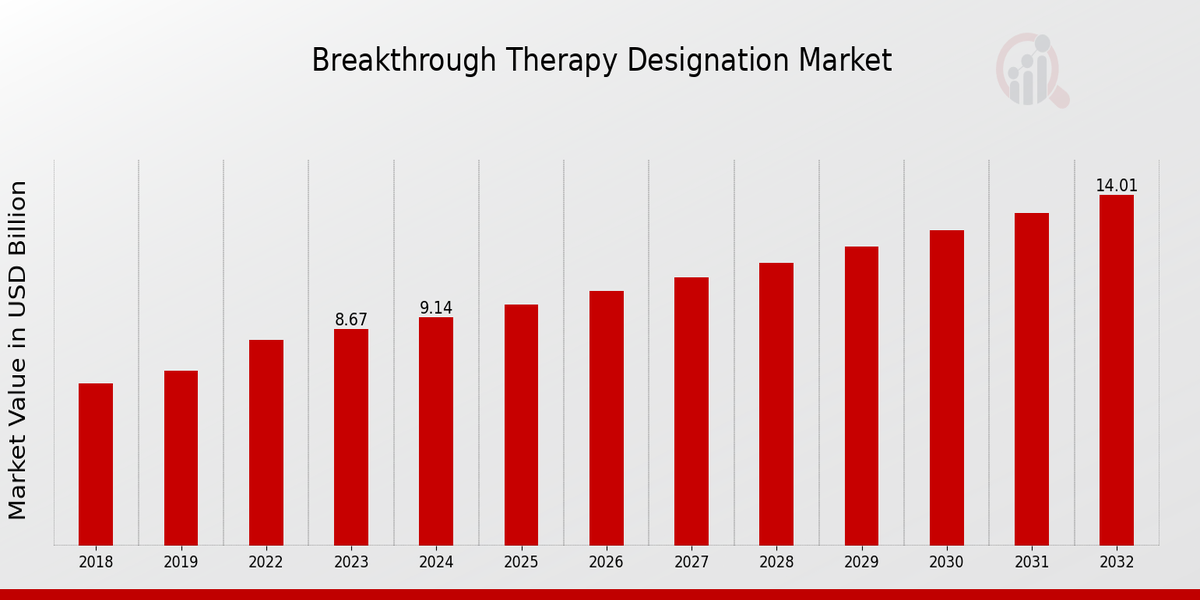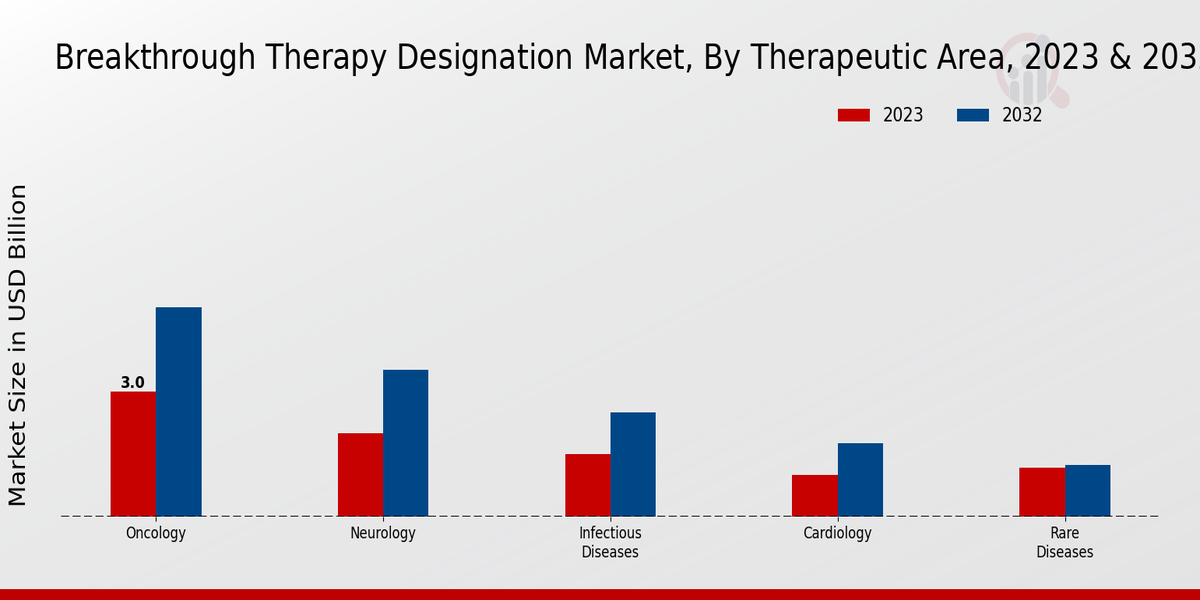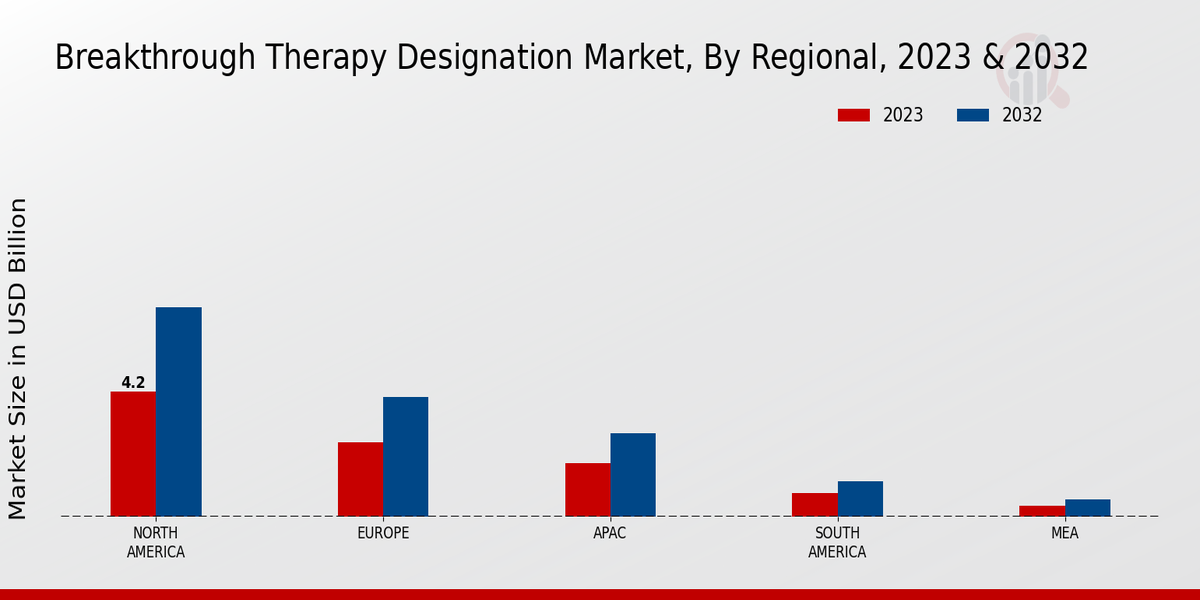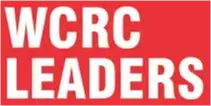Breakthrough Therapy Designation Market Overview
As per MRFR analysis, the Breakthrough Therapy Designation Market Size was estimated at 9.65 (USD Billion) in 2024. The Breakthrough Therapy Designation Market Industry is expected to grow from 10.18 (USD Billion) in 2025 to 16.45 (USD Billion) till 2034, at a CAGR (growth rate) is expected to be around 5.48% during the forecast period (2025 - 2034).
Key Breakthrough Therapy Designation Market Trends Highlighted
The Breakthrough Therapy Designation Market is witnessing significant growth driven by an increasing demand for expedited drug development processes which allows for faster delivery of innovative therapies to patients with serious conditions. This market is primarily fueled by the rising prevalence of chronic diseases and the growing focus on personalized medicine. Pharmaceutical companies are actively seeking to leverage this pathway to bring their breakthrough products to market more swiftly, facilitating improved patient outcomes. The support from regulatory authorities in encouraging the development of therapies through streamlined approval processes also contributes to the expansion of this market. Moreover, advancements in technology, including data analytics and artificial intelligence, are enabling more efficient research and development practices.
Numerous opportunities exist within the Global Breakthrough Therapy Designation market, particularly for small to mid-sized biotechnology firms looking to develop niche therapies. These companies can capitalize on the ability to receive accelerated approval for drugs that address unmet medical needs. Collaborations between larger pharmaceutical firms and smaller biotech organizations can further enhance the potential for successful drug development and commercialization. The trend towards increased investment in research initiatives, particularly for rare diseases and oncology, presents a ripe environment for innovation.
In recent times, the market has seen a notable shift towards adaptive trial designs and real-world evidence integration, enabling firms to respond more agilely to regulatory feedback and market demands. The emphasis on patient-centric approaches is also pivotal, with a growing need to involve patient perspectives in the drug development process. This alignment is fostering greater transparency and trust between stakeholders, thus reinforcing the foundations of the market. The continuous evolution of regulatory policies aimed at facilitating breakthrough innovations further solidifies the landscape for sustained growth and advancement in this vital segment of the healthcare industry.

Source: Primary Research, Secondary Research, MRFR Database and Analyst Review
Breakthrough Therapy Designation Market Drivers
Increasing Prevalence of Chronic Diseases
The Breakthrough Therapy Designation Market Industry is significantly driven by the rising prevalence of chronic diseases, such as cancer, cardiovascular disorders, and autoimmune diseases. As global demographics shift towards an aging population, there has been a notable increase in the incidence of these conditions. This surge in chronic health issues amplifies the demand for innovative and effective treatment options, thereby propelling the growth of the Global Breakthrough Therapy Designation Market.
The designation is instrumental in accelerating the development and review of therapeutics that show promise in treating serious or life-threatening conditions, ultimately bridging the gap between preclinical phases and market availability. Pharmaceutical and biotechnology companies are increasingly motivated to seek breakthrough therapy designations to expedite the delivery of these crucial products to patients in need. Furthermore, regulatory bodies around the world are prioritizing expedited reviews, enhancing the attractiveness of this designation for new drug candidates.
As patients and healthcare providers alike demand quicker access to advanced therapies, the trajectory of the Breakthrough Therapy Designation Market appears robust. This growth is expected to continue as stakeholders in the healthcare ecosystem push for innovation that addresses urgent health challenges. Not only does this trend create opportunities for pharmaceutical companies to improve patient outcomes, but it also solidifies the strategic importance of breakthrough therapy designations within the wider context of global healthcare advancements.
Additionally, the growing emphasis on patient-centric approaches in drug development and approval processes aligns with the objectives of the Global Breakthrough Therapy Designation Market, further promoting its expansion.
Technological Advancements in Drug Development
Technological innovations in drug discovery and development are critical drivers of the Breakthrough Therapy Designation Market Industry. Advancements in genomics, proteomics, and biotechnology are enabling researchers to identify new therapeutic targets more effectively and efficiently. This transition toward more sophisticated methodologies fosters the development of personalized medicine, leading to breakthrough therapies that cater to individual patient needs.
As research techniques become more refined and data analytics capabilities improve, the likelihood of discovering effective treatments for previously challenging health conditions rises significantly. Companies that leverage these advancements tend to seek breakthrough designations, knowing the potential benefits in market traction and regulatory approvals. This growing intersection of technology and healthcare emphasizes the fundamental role of innovation in propelling the Breakthrough Therapy Designation Market forward.
Regulatory Support and Incentives for Fast-Tracking Therapies
Regulatory agencies around the world are increasingly supportive of fast-tracking therapies via designations such as the Breakthrough Therapy Designation. This approach reflects a collaborative effort to address unmet medical needs more swiftly. Regulatory incentives, including shortened review timelines and reduced administrative burden, encourage pharmaceutical companies to pursue innovative treatment options for serious conditions. Such policies contribute to the growth of the Breakthrough Therapy Designation Market Industry by facilitating a faster pathway to approval, ensuring patients gain access to promising therapeutics sooner than traditional channels would allow.
Breakthrough Therapy Designation Market Segment Insights:
Breakthrough Therapy Designation Market Therapeutic Area Insights
This growth is driven by increasing healthcare investments, advancements in therapeutic innovation, and a rising demand for rapid drug approval processes due to a growing patient population and the need for effective treatments. The segmentation of the Breakthrough Therapy Designation Market reveals a comprehensive landscape with several key sub-segments, namely Oncology, Neurology, Infectious Diseases, Cardiology, and Rare Diseases, each contributing to the overall market dynamics. In 2023, the Oncology sub-segment holds substantial market revenue with a value of 3.0 USD Billion, showcasing its critical role in addressing the urgent need for novel cancer therapies.
By 2032, it is projected to expand to 5.0 USD Billion, reflecting a considerable shift towards innovative therapies that aim to improve patient outcomes. Similarly, the Neurology sub-segment is estimated to generate revenue of 2.0 USD Billion in 2023, anticipated to grow to 3.5 USD Billion by 2032 as advancements in understanding neurological disorders lead to targeted therapies for conditions such as Alzheimer’s and multiple sclerosis. The Infectious Diseases sub-segment, valued at 1.5 USD Billion in 2023, is expected to reach 2.5 USD Billion by 2032, driven largely by the ongoing global health challenges, including pandemics that necessitate rapid development and approval of effective therapeutic candidates.
The Cardiology segment, while smaller, is also on a growth trajectory, with its market value expected to rise from 1.0 USD Billion in 2023 to 1.75 USD Billion in 2032, aided by an increasing prevalence of cardiovascular diseases worldwide and the necessity for new pharmaceutical interventions. Rare Diseases are also gaining significant attention, with a current valuation of 1.17 USD Billion in 2023, anticipated to see moderate growth to 1.25 USD Billion by 2032, emphasizing the focus on developing specialized treatments for conditions with limited existing therapies.
Trends such as personalized medicine, which tailors treatment to individual patient profiles, and the rising adoption of technology in clinical trials are expected to further bolster the Global Breakthrough Therapy Designation Market, enhancing the innovation pipeline. However, challenges remain, including regulatory hurdles and the need for extensive clinical trials, which could delay market entry for breakthrough therapies. Overall, the market's segmentation reflects the diverse therapeutic needs of the global population and highlights a growing opportunity for stakeholders in the Breakthrough Therapy Designation Market industry to capitalize on unmet medical needs and expand their portfolios in response to changing healthcare demands.
The insights into the Breakthrough Therapy Designation Market revenue across the various therapeutic areas illustrate a landscape rich with potential for growth and innovation in the coming years as the focus on rapid and effective therapeutic solutions continues to intensify, addressing both prevalent and rare medical conditions while allowing manufacturers to adjust strategies to maximize value through the Breakthrough Therapy Designation Market Statistics.

Source: Primary Research, Secondary Research, MRFR Database and Analyst Review
Breakthrough Therapy Designation Market Type of Therapy Insights
The Global Breakthrough Therapy Designation Market, particularly within the Type of Therapy segment, is witnessing significant growth, fueled by innovations in medicinal technologies and an increasing prevalence of chronic diseases. As the market is expected to reach a valuation of approximately 14.0 USD Billion by 2032, this growth reflects a steady compound annual growth rate (CAGR) of 5.48 from 2024 onward. Key therapeutic sub-segments such as Monoclonal Antibodies, Gene Therapies, Cell Therapies, Protein-based Therapies, and Small Molecule Drugs play vital roles in this expansion.
Notably, the Monoclonal Antibodies sub-segment leads the market with significant revenue contributions, offering targeted treatments primarily in oncology, which is valued at 5.0 USD Billion in 2032, up from 3.0 USD Billion in 2023. Similarly, Gene Therapies and Cell Therapies are emerging rapidly, addressing conditions across various disease areas, with the Neurology sub-segment estimated to grow from 2.0 USD Billion in 2023 to 3.5 USD Billion by 2032. The Protein-based Therapies and Small Molecule Drugs also demonstrate robust potential, though with slightly smaller market shares, reflecting a trend towards personalized medicine.
Overall, the Breakthrough Therapy Designation Market data highlights critical growth drivers, including rising investment in Research and the increasing demand for advanced therapeutics, underscored by valuable Breakthrough Therapy Designation Market statistics that showcase a well-rounded industry trajectory.
Breakthrough Therapy Designation Market Administration Route Insights
The Administration Route segment of the Breakthrough Therapy Designation Market is a significant area of focus, reflecting the diverse methods through which breakthrough therapies are delivered. As the market moves towards 2024, the Administration Route is anticipated to play a crucial role in the overall market dynamics, which is projected to reach a valuation of 10.33 USD Billion by 2027 and continue growing towards a 14.0 USD Billion valuation by 2032, showcasing a steady increase in market demand driven by advancements in therapeutic innovations.
Within this segment, intravenous administration remains a leading choice due to its rapid efficacy delivery, particularly notable in oncology therapies, valued at 3.0 USD Billion in 2023 and expected to grow to 5.0 USD Billion by 2032. Subcutaneous administration is also gaining traction, especially in neurology indications, with its market size projected to escalate from 2.0 USD Billion in 2023 to 3.5 USD Billion by 2032. Oral routes, while traditionally a preferred administration method, are increasingly complemented by inhalation and topical routes, targeting specific therapeutic areas such as infectious diseases and rare diseases, which account for 1.5 and 1.17 USD Billion in 2023, respectively, expected to rise to 2.5 and 1.25 USD Billion in 2032.
This segmentation indicates diverse market opportunities as healthcare providers and pharmaceutical companies adapt to patient preferences and therapeutic needs. The Breakthrough Therapy Designation Market data suggests strong potential for innovation and evolving treatment pathways, shaped by factors including increased prevalence of chronic diseases and a demand for tailored therapies, driving overall market growth in this administration route domain.
Breakthrough Therapy Designation Market Development Stage Insights
The Development Stage segment of the Breakthrough Therapy Designation Market is pivotal to understanding the industry's growth dynamics, with the overall market expected to reach a valuation of approximately 14.0 USD Billion by 2032, from 8.67 USD Billion in 2023. This segment encapsulates various phases of drug development, including Preclinical, Phase 1, Phase 2, Phase 3, and FDA Approved therapies, each contributing uniquely to market growth. As of 2024, the market is anticipated to expand steadily, driven by increasing investments in pharmaceutical R and a growing demand for advanced therapies for serious conditions.
Each sub-segment plays a critical role, with oncology leading at 5.0 USD Billion by 2032, up from 3.0 USD Billion in 2023, reflecting the burgeoning focus on cancer treatment. Neurology also showcases significant growth, projected to reach 3.5 USD Billion by 2032 from 2.0 USD Billion in 2023, driven by rising neurological disorders. Infectious Diseases and Cardiology are evolving as promising areas, expected to grow to 2.5 USD Billion and 1.75 USD Billion, respectively, by 2032. Furthermore, Rare Diseases show a gradual increase, reflecting a greater emphasis on tailored therapies, anticipated to reach 1.25 USD Billion.
Overall, the Global Breakthrough Therapy Designation Market's segmentation illustrates its robust framework for addressing diverse medical needs through innovative development stages.
Breakthrough Therapy Designation Market Patient Population Insights
This market segmentation reveals diverse patient age groups and their differing healthcare needs. Within the pediatric sub-segment, there is a crucial emphasis on innovative therapies addressing conditions that significantly impact children, often resulting in a notable portion of the overall market revenue. The adult population remains the largest contributor, driven by a higher prevalence of chronic diseases, especially in oncology, which alone is estimated to reach USD 5.0 billion by 2032. The geriatric demographic is also becoming increasingly significant as aging populations encounter complex health challenges, spurring demand for breakthrough therapies.
Moreover, special populations, characterized by rare diseases or unique health conditions, present both opportunities and challenges for market players. As of 2024, the market statistics reveal a notable shift toward more targeted therapies, enhanced regulatory frameworks, and increasing investments in R, all contributing to the evolution of the Breakthrough Therapy Designation Market revenue and highlighting the importance of understanding its segmentation for strategic planning and resource allocation.
Breakthrough Therapy Designation Market Regional Insights
The Breakthrough Therapy Designation Market is expected to witness significant growth in the coming years, with a projected market valuation of 14.0 USD Billion by 2032, indicating a robust CAGR of 5.48% from 2024 to 2032. Within the regional segmentation, North America is anticipated to continue leading the market, driven by a strong emphasis on innovation, extensive research activities, and favorable regulatory conditions. Europe closely follows, benefiting from a growing investment in healthcare and emerging biotechnology firms. The APAC region is also set for rapid growth due to increasing healthcare expenditures and the rising prevalence of chronic diseases, while South America and MEA present unique opportunities driven by improving healthcare infrastructure and the need for advanced therapies.
The Breakthrough Therapy Designation Market segmentation presents diverse opportunities influenced by regional healthcare dynamics, policy changes, and increasing patient needs across various therapeutic areas.

Source: Primary Research, Secondary Research, MRFR Database and Analyst Review
Breakthrough Therapy Designation Market Key Players And Competitive Insights:
The Breakthrough Therapy Designation Market has gained significant attention as regulatory agencies continue to emphasize the importance of accelerating the development and approval of drugs intended to treat serious conditions. This designation is critical for pharmaceutical companies as it not only streamlines the drug development process but also enhances the potential market access for breakthrough therapies that promise significant benefits over existing treatments. Consequently, the competitive landscape has seen a surge in investments and strategic collaborations aimed at positioning companies favorably in this emerging market. The rising incidence of chronic and complex diseases has also fueled the demand for innovative therapies, leading to an increasingly competitive environment where firms must demonstrate efficacy and safety in order to capitalize on the advantages presented by the breakthrough designation.
Eli Lilly and Company has established a strong foothold in the Global Breakthrough Therapy Designation Market, leveraging its advanced technological capabilities and extensive research pipeline. The company has a robust portfolio of innovative therapies that have received breakthrough designations, which underscores its commitment to addressing unmet medical needs. Eli Lilly's strengths lie in its dedicated RD efforts and strategic partnerships that allow for accelerated drug development processes. The company benefits from a well-established infrastructure that supports clinical trials and regulatory submissions, enabling it to bring novel therapies to market swiftly. Moreover, Eli Lilly’s marketing strategies and strong relationships with healthcare providers further enhance its competitive position, allowing it to effectively communicate the value proposition of its breakthrough therapies to patients and clinicians alike.
Roche has equally made notable strides in the Global Breakthrough Therapy Designation Market, showcasing its commitment to developing groundbreaking treatments for serious diseases. With its strong emphasis on personalized medicine, Roche invests heavily in technology and innovation to support its drug development efforts. The company’s ability to engage in comprehensive biomarker research plays a pivotal role in not only identifying potential breakthrough therapies but also in optimizing their clinical applications. Roche's global presence allows it to navigate various regulatory environments effectively, which is a significant asset when pursuing breakthrough designations across different regions. The company’s strengths include its extensive experience in oncology and other therapeutic areas, as well as a reputation for high-quality clinical trials that often lead to successful breakthrough designations. Overall, Roche remains a formidable competitor in the market, continually striving to enhance patient outcomes through innovative and targeted therapies.
Key Companies in the Breakthrough Therapy Designation Market Include:
- Eli Lilly and Company
- Roche
- Johnson Johnson
- Regeneron Pharmaceuticals
- GlaxoSmithKline
- BristolMyers Squibb
- Sanofi
- Pfizer
- Merck
- Novartis
- Gilead Sciences
- AstraZeneca
- Celgene
- Amgen
Breakthrough Therapy Designation Market Industry Developments
Recent developments in the Breakthrough Therapy Designation Market have showcased a surge in interest and activity, especially as pharmaceutical companies aim to expedite the development of innovative therapies for serious conditions. Regulatory agencies like the FDA have continued to refine guidelines, enhancing clarity around the criteria for designation and encouraging applications from diverse therapeutic areas. Collaborations among biotech firms, academic institutions, and regulatory bodies have been pivotal in advancing clinical trials and obtaining faster approvals. Investments into breakthrough therapies are rising, driven by increasing prevalence of chronic diseases and the demand for efficient treatment options. The market is witnessing a notable shift towards gene therapies and personalized medicine, aligning with ongoing trends focused on patient-centric care. Amid this growth, healthcare stakeholders are emphasizing the importance of data transparency and real-world evidence to support the efficacy and safety of designated therapies, fostering a dynamic environment conducive to innovation. As we progress towards 2032, sustaining this momentum will be vital, with expectation for market expansion, projected at a valuation of around 14.0 billion USD, reflecting the evolving landscape of breakthrough therapy developments.
Breakthrough Therapy Designation Market Segmentation Insights
- Breakthrough Therapy Designation Market Therapeutic Area Outlook
- Oncology
- Neurology
- Infectious Diseases
- Cardiology
- Rare Diseases
- Breakthrough Therapy Designation Market Type of Therapy Outlook
- Monoclonal Antibodies
- Gene Therapies
- Cell Therapies
- Protein-based Therapies
- Small Molecule Drugs
- Breakthrough Therapy Designation Market Administration Route Outlook
- Intravenous
- Subcutaneous
- Oral
- Inhalation
- Topical
- Breakthrough Therapy Designation Market Development Stage Outlook
- Preclinical
- Phase 1
- Phase 2
- Phase 3
- FDA Approved
- Breakthrough Therapy Designation Market Patient Population Outlook
- Pediatric
- Adult
- Geriatric
- Special Populations
- Breakthrough Therapy Designation Market Regional Outlook
- North America
- Europe
- South America
- Asia Pacific
- Middle East and Africa
|
Report Attribute/Metric
|
Details
|
|
Market Size 2024
|
9.65 (USD Billion)
|
|
Market Size 2025
|
10.18 (USD Billion)
|
|
Market Size 2034
|
16.45 (USD Billion)
|
|
Compound Annual Growth Rate (CAGR)
|
5.48 % (2025 - 2034)
|
|
Report Coverage
|
Revenue Forecast, Competitive Landscape, Growth Factors, and Trends
|
|
Base Year
|
2024
|
|
Market Forecast Period
|
2025 - 2034
|
|
Historical Data
|
2020 - 2024
|
|
Market Forecast Units
|
USD Billion
|
|
Key Companies Profiled
|
Eli Lilly and Company, Roche, Johnson Johnson, Regeneron Pharmaceuticals, GlaxoSmithKline, BristolMyers Squibb, Sanofi, Pfizer, Merck Co., Novartis, Gilead Sciences, AstraZeneca, Celgene, Amgen
|
|
Segments Covered
|
Therapeutic Area, Type of Therapy, Administration Route, Development Stage, Patient Population, Regional
|
|
Key Market Opportunities
|
Increased RampD investments Accelerated regulatory approval processes Growing prevalence of rare diseases Enhanced collaboration between stakeholders Rise in personalized medicine initiatives
|
|
Key Market Dynamics
|
Increasing demand for rapid approvals Rising prevalence of chronic diseases Growing investment in biopharmaceuticals Enhanced collaboration among stakeholders Regulatory incentives for innovation
|
|
Countries Covered
|
North America, Europe, APAC, South America, MEA
|
Frequently Asked Questions (FAQ) :
The Breakthrough Therapy Designation Market is expected to be valued at 14.0 USD Billion in 2032.
The Breakthrough Therapy Designation Market is expected to grow at a CAGR of 5.48 from 2024 to 2032.
North America holds the largest market share, valued at 7.0 USD Billion in 2032.
The Oncology segment of the Breakthrough Therapy Designation Market is expected to be valued at 5.0 USD Billion in 2032.
Eli Lilly and Company is one of the key players significantly impacting the Global Breakthrough Therapy Designation Market.
The Neurology segment is projected to be valued at 3.5 USD Billion in 2032.
The Infectious Diseases segment is expected to be valued at 2.5 USD Billion in 2032.
The Asia Pacific region is projected to be valued at 2.8 USD Billion in 2032.
The Cardiology segment is valued at 1.0 USD Billion in 2023.
The Rare Diseases segment is expected to be valued at 1.25 USD Billion in 2032.




























